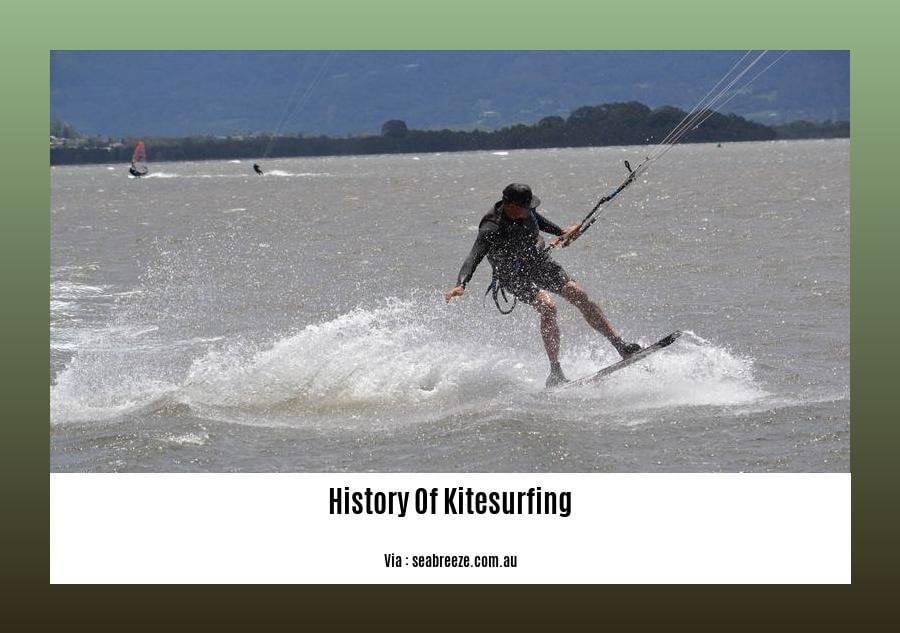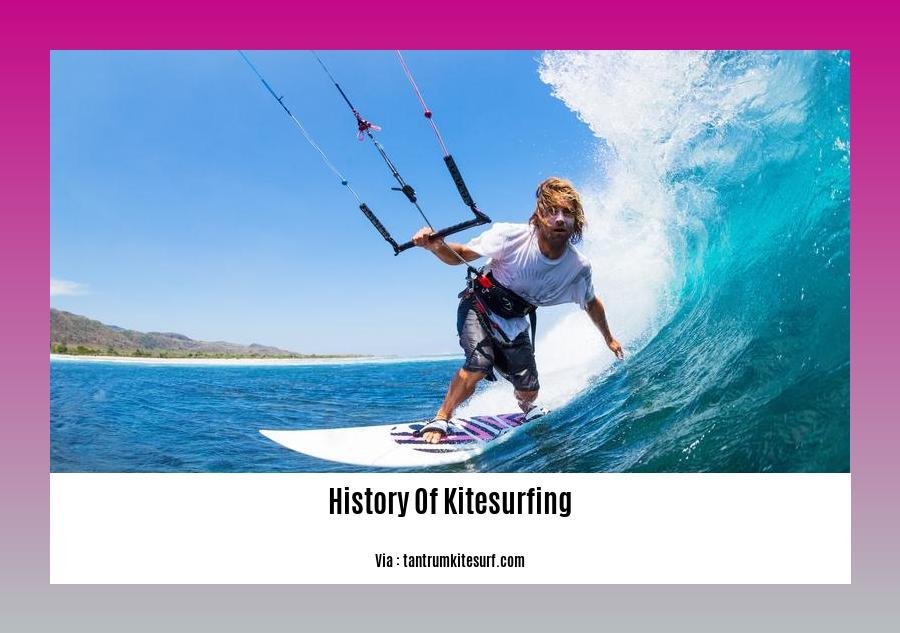Welcome to the enthralling journey of kitesurfing, where the winds of change have propelled a once-obscure pastime into a global phenomenon. Unveiling the Winds of Change: A Journey Through the History of Kitesurfing, this article embarks on an exhilarating voyage through the annals of kitesurfing, charting its remarkable transformation from a niche pursuit to a widely celebrated water sport.
Key Takeaways:
Kiteboarding involves using wind power with a large kite to navigate water, land, or snow.
Originating in the late 1970s, it gained popularity in the late 1990s.
The sport combines features of paragliding, surfing, windsurfing, skateboarding, snowboarding, and wakeboarding.
Approximately 1.5 million kitesurfers worldwide purchase an estimated 100,000 to 150,000 kites annually.
Kitesurfers use inflatable kites and control them with a bar and harness connected by flying lines.
Kite size and line length can be adjusted based on wind strength.
Competitions include freestyle, wave-riding, and racing disciplines.
It held the former speed sailing record reaching 55.65 kn (103.06 km/h), later exceeded by a sailboat.
Safety concerns exist for participants and bystanders due to potential hazards.
History of Kitesurfing

In the realm of water sports, kitesurfing stands as a captivating blend of adrenaline, grace, and innovation. Its origins can be traced back to the late 1970s when a handful of pioneers dared to harness the power of the wind and ride across the water’s surface.
The Early Days of Kitesurfing
The early years of kitesurfing history were marked by experimentation and innovation. Kite designs evolved rapidly, from simple sled kites to inflatable kites that provided greater stability and control.
Simultaneously, riders pushed the boundaries of what was possible on a kiteboard, transitioning from simple gliding to impressive jumps and tricks.
The Birth of Kiteboarding
In the late 1990s, kitesurfing emerged as a distinct sport, gaining recognition and popularity worldwide. This era witnessed the emergence of dedicated kiteboarding schools, competitions, and industry leaders who further refined equipment and techniques.
The Rise of Freestyle and Wave Riding
The early 2000s saw the rise of freestyle and wave riding as specialized disciplines within kitesurfing. Freestyle riders showcased their skills with intricate aerial maneuvers, while wave riders conquered the power of ocean waves, performing gravity-defying jumps and carving turns.
Kitesurfing Today
Today, kitesurfing has become a global phenomenon, with millions of enthusiasts worldwide. The sport continues to evolve, with new innovations in kite design, riding techniques, and safety standards.
Kiteboarding competitions attract top-tier athletes who push the limits of the sport, inspiring a new generation of riders.
The Future of Kitesurfing
The future of kitesurfing looks bright. With ongoing advancements in technology and a growing community of passionate riders, the sport is poised for continued growth and diversification.
Whether it’s exploring new riding spots, pushing the boundaries of freestyle tricks, or simply enjoying the thrill of riding the wind and waves, kitesurfing offers limitless possibilities for adventure and personal fulfillment.
Are you a music enthusiast eager to know the intriguing history of keyboard instruments? Look back in time with us and delve into the rich journey of these musical wonders. history of keyboard instruments
Lacrosse, a sport with a long and storied past, has captured the hearts of many with its fast-paced action and strategic gameplay. Embark on a fascinating journey through the history of lacrosse timeline, exploring the evolution of this beloved sport from its ancient origins to the modern-day spectacle it has become.
Experience the captivating allure of JDM cars, a true phenomenon that has left an indelible mark on the automotive world. Unleash your passion for speed and precision as we explore the history of JDM, tracing the roots of these iconic machines and uncovering the stories behind their legendary status.
Evolution of Kitesurfing Disciplines
Since its humble beginnings in the 13th century, kitesurfing has come a long way. Originally just a novelty, the sport has grown into a global phenomenon that encompasses multiple disciplines, attracting enthusiasts from all corners of the world.
A Glimpse into the Past
In the early days, kitesurfing was primarily about exploring the limits of what was possible on the water. Pioneers like Manu Bertin and Laird Hamilton pushed the boundaries of the sport, constantly innovating and refining their techniques.
The Birth of Disciplines
As kitesurfing gained popularity, different styles and disciplines began to emerge. Freestyle, with its focus on aerial maneuvers and tricks, became a crowd-pleaser. Wave riding, on the other hand, allowed riders to harness the power of the waves, carving and jumping with grace and precision.
Progression and Refinement
Over the years, each discipline has evolved significantly. Freestyle riders have taken their tricks to new heights, defying gravity with seemingly impossible rotations and flips. Wave riders have honed their skills, mastering the art of riding the waves with fluidity and control.
Embracing Diversity
Today, the diversity of kitesurfing disciplines is astounding. From freestyle and wave riding to hydrofoiling and kite landboarding, there’s a discipline for every type of rider.
A Sport for All
The evolution of kitesurfing disciplines has made the sport more accessible and enjoyable for a wider range of people. Whether you’re a seasoned pro or just starting out, there’s a discipline that suits your skills and preferences.
Key Takeaways:
Kitesurfing has transformed from a niche activity to a global phenomenon with multiple disciplines.
Freestyle and wave riding emerged as specialized disciplines in the early 2000s.
Ongoing innovations continue to shape kite design, riding techniques, and safety standards.
Kitesurfing disciplines offer something for everyone, from seasoned pros to beginners.
The future of kitesurfing appears bright, with continued growth and diversification.
Citations:
Global Spread and Growth of the Kitesurfing Community:

Imagine the exhilarating rush of gliding across the water’s surface, propelled by the wind’s invisible force. That’s the essence of kitesurfing, a sport that has captivated adventurers worldwide, weaving a tale of global spread and growth.
From humble beginnings to a globally recognized phenomenon, kitesurfing’s journey is a testament to human ingenuity and the allure of riding the waves with the power of the wind. Buckle up as we dive into the captivating narrative of how this exhilarating sport has taken the world by storm.
1. The Birth of a Thrill: A Kite’s Tale
In the realm of water sports, innovation often emerges from a fusion of existing elements. Kitesurfing is no exception, tracing its roots back to the convergence of kites, surfboards, and a thirst for adventure.
Dutchman Gijsbertus Adrianus Panhuise, a visionary inventor, patented the modern form of kitesurfing in 1977, envisioning a thrilling sport where a kite-powered surfboard would dance across the waves. His patent laid the foundation for the sport’s future development.
2. Riding the Wind’s Embrace: The 1990s Renaissance
The 1990s witnessed the dawn of a new era for kitesurfing. The introduction of safer and more controllable kites, coupled with the pioneering efforts of windsurfing legends like Manu Bertin and Laird Hamilton, propelled the sport into the limelight.
Hamilton’s groundbreaking kiteboarding video, released in 1999, captivated audiences worldwide, showcasing the sport’s mesmerizing blend of grace, power, and freedom. Kitesurfing had officially arrived on the global stage.
3. Community Unbound: The Dawn of a New Millennium
As the new millennium dawned, kitesurfing’s growth trajectory reached new heights. The sport’s accessibility, coupled with the establishment of dedicated schools and competitions, fueled a surge in enthusiasts worldwide.
Kiteboarding, as it was also known, carved a niche for itself in the action sports arena, attracting thrill-seekers eager to harness the wind’s power and ride the waves like never before.
4. Crossing Borders, Uniting Souls: A Global Phenomenon
Today, kitesurfing’s reach extends far beyond its humble beginnings, with millions of passionate individuals embracing the sport’s allure. From the pristine beaches of Brazil to the rugged coastlines of Australia, kitesurfing communities have sprouted across the globe.
The internet has played a pivotal role in fostering this global interconnectedness, enabling kitesurfers to share experiences, techniques, and stoke-filled videos, further fueling the sport’s exponential growth.
Key Takeaways:
- Kitesurfing emerged in the late 1970s, combining wind power and water sports.
- The 1990s marked a pivotal era, with the introduction of safer kites and the pioneering efforts of windsurfing legends.
- The establishment of dedicated schools and competitions fueled a global surge in kitesurfing enthusiasts.
- The internet has played a crucial role in connecting the global kitesurfing community, fostering a vibrant exchange of experiences and stoke.
Sources:
Impact on Tourism and Local Economies
Kitesurfing is not just a thrilling sport; it also leaves a significant wake of positive economic impact. Think about it – when kitesurfing enthusiasts flock to a destination, they don’t just bring their boards and kites; they also bring their wallets.
They spend money on accommodations, food, transportation, and other local services. This influx of cash provides a much-needed boost to the local economy.
The Ripple Effect
The economic benefits of kitesurfing extend far beyond the immediate tourism industry. When kitesurfers visit a destination, they often frequent local shops, restaurants, and bars. This increased business activity creates jobs and stimulates economic growth throughout the community.
Local businesses aren’t the only ones who benefit from kitesurfing tourism. Many destinations also see an increase in tax revenue, which can be used to fund important public services like education, infrastructure, and healthcare.
Sustainability and the Future
Kitesurfing is a relatively sustainable form of tourism. It doesn’t require much infrastructure, and it doesn’t pollute the environment. This makes it an attractive option for destinations that are looking to develop their tourism industry without compromising their natural resources.
As kitesurfing continues to grow in popularity, it’s likely that we’ll see even more destinations embracing this exhilarating sport. The economic benefits of kitesurfing tourism are simply too good to ignore.
Key Takeaways:
- Kitesurfing tourism has a significant economic impact on local destinations.
- Kitesurfers spend money on accommodations, food, transportation, and other local services.
- This increased business activity creates jobs and stimulates economic growth.
- Kitesurfing tourism is a relatively sustainable form of tourism.
- As kitesurfing continues to grow in popularity, more destinations are likely to embrace this exhilarating sport.
Sources:
- Kitesurfing: A New Economic Driver for Coastal Communities. [ResearchGate]
- The Economic Impact of Kitesurfing in the United States. [International Kiteboarding Association]
FAQ
Q1: What significant role did Manu Bertin and Laird Hamilton play in the history of kitesurfing?
A1: Manu Bertin and Laird Hamilton, two renowned Hawaiian windsurfers, played a crucial role in popularizing kitesurfing as a water sport in the 1990s, helping to bring it to the forefront of extreme sports.
Q2: What was the primary motivation behind George Pocock’s experimentation with kites in the 19th century?
A2: In the 19th century, George Pocock’s primary motivation for experimenting with kites was to enhance the speed of carts on land and ships on water. His innovative use of kites for propulsion laid the foundation for future developments in kitesurfing.
Q3: What technological advancements in the late 1970s contributed to the evolution of kitesurfing?
A3: In the late 1970s, the creation of Spectra and Kevlar flying lines, coupled with the development of more controllable kites, marked a pivotal moment in the history of kitesurfing. These advancements significantly improved the safety and accessibility of the sport, paving the way for its widespread adoption.
Q4: Who is credited with envisioning the modern form of kitesurfing as we know it today?
A4: Dutch inventor Gijsbertus Adrianus Panhuise is widely recognized for patenting the modern form of kitesurfing in 1977. His visionary concept of a surfboarder being pulled by a kite laid the groundwork for the sport’s subsequent development and global appeal.
Q5: What is the significance of tourism in the context of kitesurfing’s impact on local economies?
A5: Tourism plays a vital role in the economic development of regions where kitesurfing is popular. By attracting tourists seeking adventure and water sports, kitesurfing generates revenue and creates job opportunities, contributing to the overall economic growth and prosperity of local communities.















